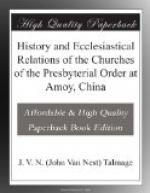Perhaps it will be thought that schism is too hard a term whereby to designate the separation of the Church at Amoy. Never mind the word, then, but let us look at the facts. The proper Classis of Amoy, composed of all the churches of like order, and of the Missionaries, has proceeded, according to the order of our Church, to ordain and install native pastors, and to perform a few other necessary ecclesiastical acts. These pastors are now called on to separate from, and break up that body, through which they received their office! The opinions and wishes of these native pastors, as well of the native Classis, and the native churches, are all ignored! Are such things right? Are these the doctrines or policy of the Dutch Church? We are told that we need say nothing to the native churches on the subject. Is this right? Is the Dutch Church a hierarchy? Does the General Synod claim authority to order the division in such a manner of a Classis of the Church of Christ without the consent of that Classis? “What God hath joined together let not man put asunder.”
In consequence of fallen humanity, there are evils which we call necessary evils. Such is the case of different Denominations of Christians in the same region of territory. They differ in sentiment on important (or supposed to be important) subjects, and because of this difference in sentiment, they can work together in greater harmony, and with greater efficiency, by being formed into distinct organizations. Such, however, is not the case of the six churches at Amoy, and others growing up under their care and the care of your own and the English Presbyterian Missionaries. Even when Churches agree in doctrine and order, it is sometimes better, and sometimes necessary, in consequence of geographical separation or national distinctions, to form distinct organizations. It is better, or necessary, that the Churches in Holland, and America, and South Africa, be ecclesiastically distinct. We do not call this an evil, for all the advantages of ecclesiastical courts and control are better thus secured. But suppose a case. There are, say, thirty Dutch churches in the city of New York. Now, suppose there were no others of the same order throughout this whole land: instead of allowing these churches to remain one organic whole—forming Classes and Synods, as the growth and convenience may allow and direct—it is proposed to take one-half of these churches, form them into a distinct organization, thus depriving them of ecclesiastical relations to the other half, and attach them to an ecclesiastical body in China—a nation of different customs and different language. How should we designate such an act? The first part would be schism, and the last part would be folly. The only difference between such a procedure and that required of us is, that the churches at Amoy have been gathered partly by our instrumentality, and are dependent partly on us for instruction. If our




